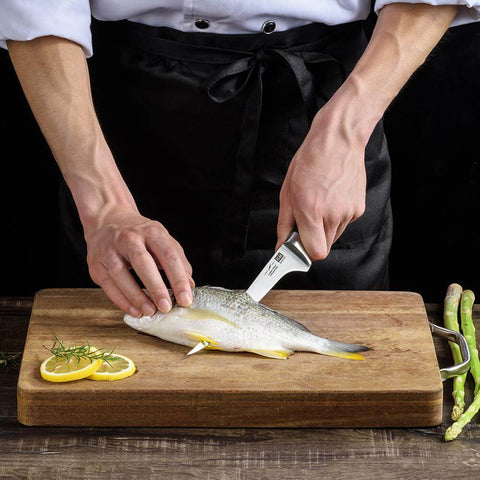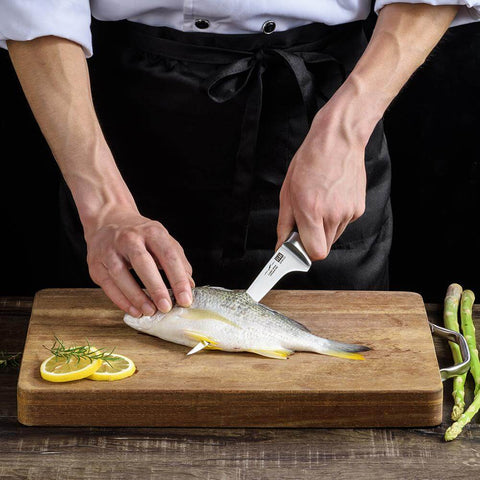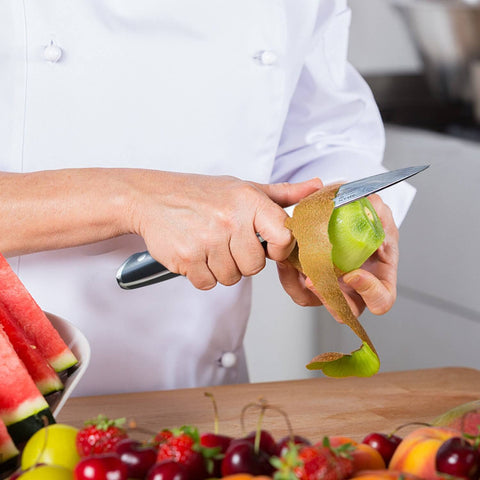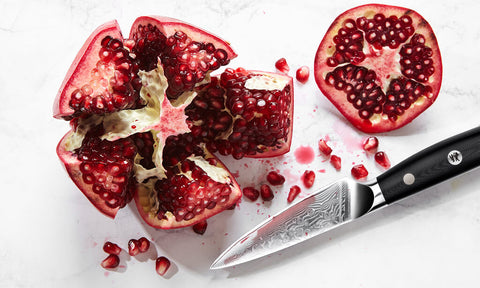What Is a Filleting Knife?
A filleting knife is used primarily for cutting poultry into thin slices. It is specifically used to remove the skin from the meat, and since it is used to slice chicken or fish, both of which are quite fragile types of meat, the design of a filleting knife is critical to getting a neat cut.
Design
Filleting knives are distinct in their appearance as they are slimmer than the usual knives used for chopping and cutting. The blade of the knife is narrow and tappers along the end to allow users to cut very thin slices precisely if necessary. Overall, the knife's blade is nearly two-thirds the length of the handle, making it easy to hold and be accurate with the cutting.
Features
The most striking feature of any fillet knife is its slim appearance and razor-sharp edge. The tip is pointed to make it possible to puncture the meat. It is a knife designed specifically to achieve precision in cutting and make cuts with the most delicate meats without ruining the integrity of the meat itself. Another special characteristic of the fillet knife is the flexibility of the blade. The knife is used to work with flesh rather than bone, and the flexibility makes it easy to maneuver it along skin, flesh, or cartridge.
Length of the blade
The typical length of a fillet knife is 15 to 28 cm or 6 to 11 inches. The common variations in the length of the blade for fillet knives range from 4 to 6 inches, 7 to 8 inches, and 9 to 11 inches, and each type is suitable for different types of fish. Smaller fish like Trout or Mackerel require a fillet knife with a shorter blade, whereas larger fish, Tuna, Catfish, or Halibut, are worked on by long-bladed fillet knives.
What Makes a Good Fish Fillet Knife?
Certain attributes need to be carefully considered when determining how good a fillet knife is. Professional knives can be quite costly but are regarded as a worthwhile investment due to their functionality and durability. Judging the performance and longevity of a good knife depends on the following factors:
Material
The material of the blade is crucial to determine the longevity of a filleting knife. The blade of a filleting knife must be made out of stainless steel with a high-carbon content. High-carbon content is important to ensure that the blade is resistant to corrosion since filleting knives are used primarily on fish and come into contact with seawater regularly. Without high-carbon, stainless steel filleting knives have a much lower life span.
Thin, Flexible Blades Sharp-Edged Blades
The blade of a filleting knife is also unique in its sharpness and width. The blade is extremely thin. Since it is supposed to slice flesh while leaving the bone intact, the thinner blade offers greater control and flexibility means that any bones present can be avoided while making cuts. Cutting bones without a proper blade is likely to simply break them and make them even harder to extract.
Another aspect of the blade is its sharpness. Filleting knives are extremely sharp and need to be handled with care. The knife's edge usually has an angle of just 12-17 degrees which shows just how acute the razor edge is.
Blade Length
The blade length for a filleting knife ranges from 6 to 11 inches. As already mentioned, filleting knives come in different blade lengths to match the size of the fish. Shorter blades are great for smaller fish, while longer blades are ideal for cutting and skinning larger fish.
Handle Type
The handle is traditionally made out of wood, though now knives with high-quality plastic or rubber are common. The shape and material of the handle are more of a personal preference rather than having an impact on how a knife performs. Wooden handles are very sturdy and add weight to the knife, making handling and using the knife easier. Though wood can get slippery and hard to hold when wet, it is not the easiest to clean. Plastic and rubber handles offer a much stronger grip and are easy to clean but may not be as sturdy as wooden ones. Ergonomically shaped handles nowadays also improve the grip on the knife while relieving the user of some of the stress.
What Is the Best Knife for Filleting Fish?
A filleting knife is a perfect tool for filleting fish or cutting any kind of fleshy meat that requires precision. The thinness and sharpness of the blade make it ideal for slicing the soft and delicate meat and for removing the skin from the flesh in a single swipe.
The flexibility of the blade makes it easy to control the knife and avoid any bones that may have been missed during the deboning process. The upward curvature of the blade and the pointed tip is perfect for getting rid of scales as well as making punctures or achieving thin slices.
What Is the Difference Between a Fillet Knife and a Boning Knife?
Many people do not consider the different types of knives and just how varied they are in their appearance and usage. Trained professionals, however, greatly depend on their tools and know just how important it is to utilize the right type of knife for the right purpose. Two commonly confused types of knives include the boning knife and the fillet knife.
What is a Boning Knife Used For?
A boning knife is used specifically to separate bones and flesh. The knife is generally flat and has a straight blade with a slight curvature and a sharp tip. The length of the blade falls between 5 to 7 inches, and it is sharp enough to cleanly cut through connective tissues and ligaments so that the bones are removed from the meat cleanly and without causing any damage to the meat itself. The boning knife has a denser blade so it can bear the force when cutting near the bone, but it is also flexible enough to provide greater control.
What is a Fillet Knife Used For?
A filleting knife is used for cutting through flesh and is used once the meat has been deboned. The idea is to get precise cuts of fish or meat. Any bones remaining in the meat are left intact, so they do not break and can be removed later on with a boning knife if necessary.
Due to their varying purposes, the boning and filleting knives are drastically different in appearance and functionality. A filleting knife has a longer blade that is thinner and more flexible. While both are extremely sharp, one is used to separate bones while the other is used to slice and cut the flesh and remove the skin. Both knives are used to prepare the fish for further cooking, but the boning knife is used first to get rid of the bones, and then the filleting knife is used to cut the flesh.
Fillet vs. Carving Knives
Carving knives are also quite commonly used and may get wrongly labeled as filleting knives. However, there is a difference.
What's the difference?
The key difference between a carving knife and a filleting knife is the blade. While carving knives also have a thin blade, it is much wider than that of a filleting knife.
Examples of a fillet knife

Fillet knives come in many different sizes and types, depending on the material, design, and whether the knife is manual or electric. Some great ones include the Shun Classic flexible filleting knife, which is a high-quality Japanese knife. The Wusthof Classic filleting knife is in a mid-range when it comes to price. A more affordable option also includes the Victorinox Fibrox filleting knife.
What is a carving knife?
A carving knife is designed to cut through the meat. It has a long thin blade, which is wider than the blade of a filleting knife since it is used for meat that is less delicate than the one filleting knife is used on. The blade for a carving knife is flexible as well as allowing for better control.
Examples of a carving knife
There are many different types of carving knives available in the market, each with a specialized purpose. These include rounded tip slicers which do not have a sharp point. Instead, the tip is rounded, and the knife is generally used for slicing delicate cuts of meat, like ham and even salmon. Since the tip is not sharp, very thin slices are difficult to cut.
Another type of carving knife commonly found is the serrated-edge carving knife. The blade, as the name suggests, is not straight but has tiny teeth. The serrated edge is not good for cutting through meat or fish but is perfect for such things as bread of any kind.
What Kind of Knife Do You Use to Cut Fish?
Examining the different types of knives and their various features, it can be concluded that the filleting knife is the most suitable for cutting fish. The filleting knife is designed specifically to slice through the soft flesh and achieve clean cuts. However, preparing fish for cooking or further processing requires the help of other kinds of knives as well. Before the fish is cut, it needs to be deboned, and the boning knife is used to fulfill this task. While home chefs and casual cooks may not use specialized knives, in a professional setting where chefs have to prepare large amounts of high-quality cuts of fish and meat, the right kind of knife plays an integral part.
Uses of Filleting Knife You Never Knew
Since a good filleting knife can cost a fortune, some people may be hesitant to purchase them. The amount of fish needed to be prepared for own use may not justify the high cost of the knife. However, even though it is a specialized knife, it does have multiple uses . The unique and high-quality design makes it suitable for:
Filleting Meat with More Precision
Longer filleting knives are great for achieving thin slices of meat, especially the more delicate cuts like the tenderloin. The knife provides a precise and even cut if you do not have a carving knife to do the same.
Slicing Fruits & Vegetables
Much like flesh, fruits and vegetables do not have bone and can be cut easily with a fillet knife. In fact, unlike fish which can be needed to be held due to its soft texture, many fruits and vegetables are sturdy enough to require very little pressure to keep in place.
Decorate Your Salads and Vegetables
We already know that a filleting knife can work well for cutting, slicing, and dicing fruits and vegetables. But it is very useful for cutting vegetables and fruits in intricate styles for decorative purposes.Carving fruits and vegetables is an art that requires a sharp and precise blade, both characteristics that are available in a filleting knife.
Cleaning Fish
The razor-sharp edge and the pointed tip of a filleting knife are great for cleaning out fish. Removing the fish's guts, eyes, and gill, without damaging the soft flesh is a job requiring a lot of skill and the right knife. The filleting knife does the job perfectly when held by an expert.
Where should you get your fillet knife?
There are plenty of places that sell knives but getting one for professional use is very different. Professional chefs only buy from well-known knife craftsmen who sell premium knives at a high price. The good thing about getting the high-end price is that they are a long-term investment and can perform efficiently for years to come. Chefs rely heavily on their knives and for them getting the perfect knife, regardless of the cost, is important.
For home use or more casual cooks, there are more affordable options in the market; you can even get some great deals online. The thing to note is how you buy the knife you are looking for, that is, checking the knife for the features you desire and need in a good filleting knife.
What do you need to check when getting a fish fillet knife?
To help you get started, here are some features that need to be examined closely before you buy a filleting knife. You must check the knife for:
Material of handle & blade
The blade needs to be made out of high-carbon stainless steel, especially if you know you will be working regularly with seawater fish. Make sure to ask the right questions; otherwise, you will be left with a knife that will become brittle very quickly. As for the material of the handle, it depends upon personal preference. Some people like the weight and stupidity of a wooden handle, but sometimes cleaning it can be difficult. Wood also becomes slippery when wet, so going with plastic, rubber, or even a textured steel handle may be better.
Sheath
Having a sheath is always beneficial as the cover protects the blade against any damage. When knives are stored together with other kitchen tools, the blades may experience wear and tear. With a cover on top, this can be avoided, and the integrity of the knife can be maintained for longer.
Electric Fillet Knife
Electric fillet knives are also available though they can be tricky to use. While they provide speed, it comes at the cost of control. Electric knives can slice through flesh more quickly, but it is easy to make mistakes with such a tool without proper training.
Length of the blade
The length of the blade again depends upon your preference. Most people deal with smaller to medium-sized fish on the regular, so having a filleting knife with a smaller blade will work just fine. Similarly, if you are someone who has to cut and clean bigger fish more often, then getting a longer one is much better.
Flexibility
Blade flexibility is an important feature since this allows the user to avoid the bones and make more accurate cuts.
Type of fillet knife
Depending upon the setting, home, or professional kitchen, and the frequency of usage, you can decide whether to get a fillet knife that is high-end or more affordable. This, again, depends upon your preference.
Knife origin
Any knife connoisseur knows just how important the origin of a knife is. The top places that make the best knives include Japan and Germany.Japan comes as no surprise since the nation depends heavily on its seafood and such delicacies as the Kobe beef. Germany, specifically Solingen, also known as 'The City of Blades', is another well-known manufacturer of high-quality kitchen knives.
Ergonomics and safety features
Tea grip is critical to determining how well a knife performs and how easy it is to maneuver while keeping you safe from cuts. The best way to test this out is by actually holding the knife and experiencing whether the design is ergonomically optimal for your hand. How well does the handle contour with your hand, and is it comfortable to work with even after many hours of cutting, especially when some pressure is involved? These questions can be answered by taking the knife for a 'test drive'.
Price
Filleting knives in all kinds of price ranges. The cheaper ones range from $20-$30 while the more expensive ones can be as high as $100-$200. How much you are willing to spend is dependent upon your budget and the kind of knife you are looking for.
Tips on sharpening your fillet knife
Keeping your knife sharpened is necessary to get the most out of your fillet knife. There is a proper way you need to sharpen the knife so that the blade is sharpened and does not get damaged. For the less experienced getting an electric knife sharpener to ensure that you do not get yourself hurt. There are two different types of electric sharpeners, one that removes the steel and makes the blade slimmer and the other which hones the blade.
Using a stone to sharpen knives is up to the most skilled, but you can follow some simple tips to get the best results. You will need a bevel edge of 12 to 15 degrees. The usual bevel edge for a kitchen knife is 20 degrees, but this needs to be more acute for a filleting knife. Set the slope at an angle; for 12 degrees, this usually means the height of two quarters stacked together. Once the perfect setting is achieved, start moving the edge of the knife away from yourself and then back towards yourself. Keep this motion until you know that the blade is sharpened. To see whether the blade has been sharpened, test it out. Also, note that there is a visible burr, which is a raised edge that forms on the opposite side of the blade. Once the burr is visible, you will know that you have sharpened the fillet knife enough.
Boning Knife vs. Fillet Knife FAQs
1. Who makes the best boning knives?
Some of the best boning knives include the Wusthof classic boning knife, the Shun cutlery classic, and the Mercer Culinary Genesis. For a more professional option, the KYOKU-7-inch Daimyo Series is among the best.
2. Is a fillet knife better than a boning knife?
One is not necessarily better than the other because the two are used for different purposes. The boning knife isolates the bones from the meat, while the filleting knife is for cutting and slicing fish and meat. The two may be used together for food preparation.
3. Is a boning knife necessary?
Not really, unless you are in a professional setting and need all the right tools to prepare the fish or meat for paying customers. A filleting knife can be used for deboning as well when used correctly.
4. When to use a fillet knife?
A filleting knife is mostly used for cutting, deskinning, and cleaning fish. But it can be used in the place of boning or even a carving knife. You can even use the knife for cutting vegetables and fruits; the sharp blade also makes more detailed decorative cutting simple.






Comments (0)
There are no comments for this article. Be the first to leave a message!